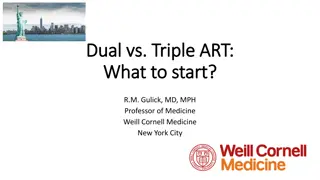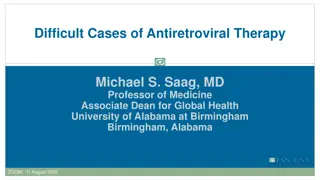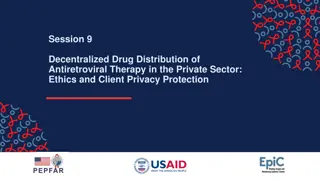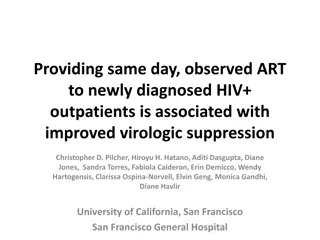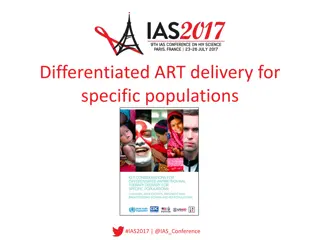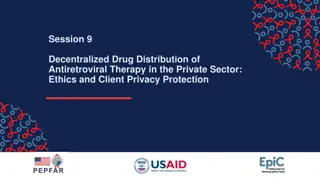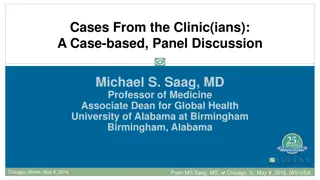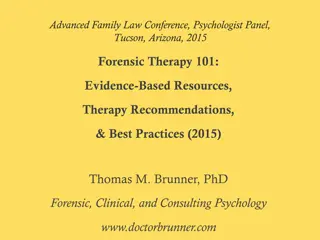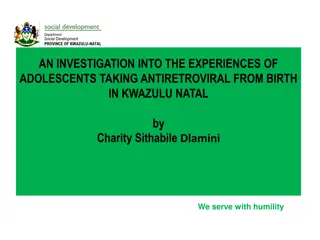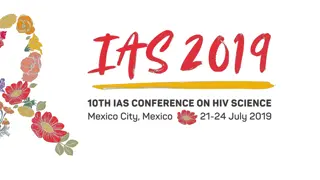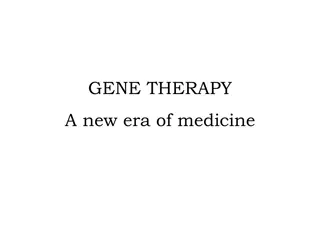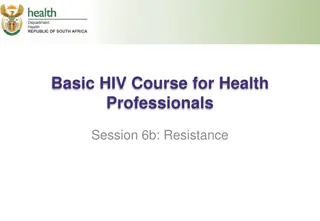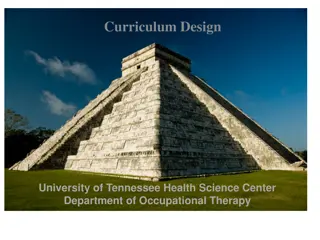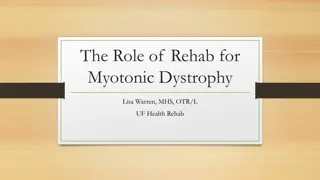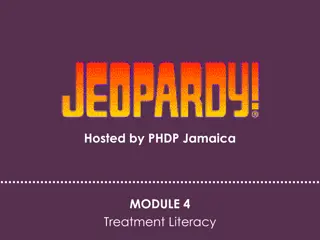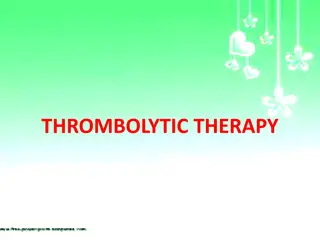Comprehensive Guide to Antiretroviral Therapy for Health Professionals
This educational session covers the essentials of antiretroviral therapy (ART) for HIV treatment, including starting medication in adults, mechanisms of action, side effects, and drug interactions. It emphasizes the goals of ART such as viral load suppression and immune restoration, outlines preparation steps for ART initiation, and details the assessment process for clinic visits during treatment. The session aims to equip healthcare professionals with the knowledge needed to provide effective care to HIV-positive individuals.
Download Presentation

Please find below an Image/Link to download the presentation.
The content on the website is provided AS IS for your information and personal use only. It may not be sold, licensed, or shared on other websites without obtaining consent from the author. Download presentation by click this link. If you encounter any issues during the download, it is possible that the publisher has removed the file from their server.
E N D
Presentation Transcript
Basic HIV Course for Health Professionals Session 5: Antiretroviral Therapy
Learning Objectives By the end of this session participants should be able to: Describe the process of starting antiretroviral (ARV) medication in adults Describe ARV mechanism of action Explain ARV side effects Describe ARV drug-drug interactions
Introduction: Overview of ART Antiretroviral therapy = ART = drugs to treat HIV Goals of ART include: Maximum and long-lasting suppression of viral load Restoration and/or preservation of immune function Improvement of quality of life Reduction of HIV-related morbidity (OIs) and mortality
Preparation for ART Initiation (1) All HIV positive patients are eligible for same day ART, regardless of CD4 count and clinical staging Preparation for initiation should include: TB screening Clinical staging and CD4 count Screening and management of STIs Counselling This Photo by Unknown Author is licensed under CC BY-NC-SA
Preparation for ART Initiation (2) Support for disclosure and partner notification Screening and management of co- morbidities Repeat CD4 testing and WHO clinical staging 6-monthly in those not ready to begin ART Annual pap smear for all HIV- positive women
Preparation for ART Initiation (3) Educate him/her on benefits of treatment and possible side-effects Consider nutritional status of patient, co-morbidities and possible drug-interactions, and address any mental health and substance abuse issues
ART Assessment for Clinic Visits Commencement Visit Reassess ART readiness Conduct a physical examination Review laboratory investigations Prescribe ART regimen Dispense ART Supply supplements if eligible Nutrition education First Visit Subsequent Visits If pregnant or breastfeeding, initiate ART same day Complete medical history Physical exam Laboratory tests Screen for TB Screen for STIs Check on need for Pap smear and family planning. Identify & treat OIs Promote adherence Promote prevention and support Initiate same-day ART if patient ready Start co-trimoxazole and/ or INH as according to guidelines Nutrition assessment and counselling Physical exam Evaluate psychosocial support Identify need for lab tests Evaluate laboratory results Promote PMTCT or contraception Promote prevention and support Information and education session Initiate ART as per next column Growth monitoring and supplementation if eligible, otherwise nutrition education
Timing of ART Initiation ART should be started as soon as the patient is ready and within 2 weeks of CD4 count being done. All HIV-positive pregnant or breastfeeding women, with no active TB or contradiction provide DTG and EFV based regimen and their implication for this and subsequent pregnancies Should be done with those patients who are: HIV stage 4 Patients with CD4 200 cells Start TB treatment first, followed by ART as soon as possible and within 8 weeks If CD4 <50 cells, then initiate ART within 2 weeks after starting TB treatment, when patient s symptoms are improving and TB treatment is tolerated. If CD4 >50 cells, then initiate ART within 2-8 weeks after starting TB treatment Immediate Priority Fast Track Initiation Co- Infection with TB
NRTI & NNRTI How ARVs Work Protease Inhibitor Integrase Inhibitor 9
Classification of Antiretroviral Therapy Drugs Type of ART Nucleoside/ Nucleotide Analogs (NRTIs) Drug Notes NOTE: Lamuvidine and Tenofovir are effective treatment for Hepatitis B. Always check hepatitis B before stopping TDF or 3TC. If a patient has chronic hepatitis B, stopping TDF or 3TC may lead to a fatal hepatitis flare. If hepatitis B positive, TDF or 3TC should be continued as a 4th drug in second-line regimen.* Abacavir (ABC) Emtricitavine (FTC) Lamuvidine (3TC) Zidovudine (AZT) Tenofovir (TDF) Efavirenz (EFV) Nevirapine (NVP) Non-nucleoside reverse transcriptase inhibitors (NNRTIs) Protease inhibitors (PIs) Atazanavir (ATV) Darunavir (DRV) Lopinavir/ritonavir (LPV/r) Dolutegravir (DTG) Integrase inhibitors (INSTIs)
Dolutegravir Why are all the excitement about DTG? TDF, 3TC, and DTG (TLD) is a potent ART regimen Superior efficacy and faster rate of viral suppression Well tolerated High genetic barrier to resistance No drug interactions with contraception
DTG: Dosages and Formulations Class of ARV: Integrase Inhibitor (InSTI) Standard Dose: DTG 50mg daily Who may get DTG? Children, adolescents and adults > 20 kg: Formulations: DTG 50 mg tablet children and adolescents 20 - 35 kg Fixed-dose combination: TLD Tenofovir (TDF) 300 mg + lamivudine (3TC) 300 mg + DTG 50 mg (TLD). TLD can be prescribed for patients > 35 kg and > 10 years of age (restricted by TDF). DTG dose with concomitant TB Treatment: Double DTG dose to 50 mg 12-hourly. If on TLD FDC, add DTG 50 mg 12 hours after TLD dose > 20 kg
1st Line Regimens for Women and Adolescent Girls
Switching between EFV and DTG in stable patients Overarching principle: Never change only one drug in a failing regimen! A single drug switch to DTG requires a VL of < 50 c/mL in last 6 months Also remember to: o Counsel patients on risks and benefits of DTG vs EFV, and the risk for NTDs in subsequent pregnancies in WOCP o Provide counselling on contraception post-partum to WOCP o Check for potential drug interactions o Warn the client about new side effects that may be experienced when switching to a new drug o Offer patient a choice of remaining on EFV or switching to DTG
Second Line Regimen for Late Adolescents and Adults Second line regimen: adolescents 15 years and adults First line virological failure Drugs Comments If non-adherent, address causes of non-adherence Failing on TDF/ 3TC or FTC/NVP or EFV Switch to AZT/3TC* + DTG If the VL >1000copies/mL at any point, intensify adherence and repeat VL in 2 months Failing on AZT/3TC/NVP or EFV If VL remains at >1000 copies/mL after 2 months, then switch to second line regimen * All patients switching off TDF should have their Hepatitis B status checked Switch to TLD Dyslipidaemia (total cholesterol >6 mmol/L) or diarrhoea associated with LPV/r Anaemia and renal failure Switch LPV/r to ATV/r Switch to ABC
Case Studies: Determining When and What to Start Cases in Adults
Immune Reconstitution Inflammatory Syndrome (IRIS) IRIS is: A spectrum of clinical signs and symptoms resulting from [body s] restored ability to mount an inflammatory response associated with immune recovery WHO, 2006
Risk Factors for IRIS Initiating ART within close proximity of diagnosis of an OI Decrease in plasma HIV RNA (viral load) level Low baseline CD4 (<50) prior to starting ART Being ART na ve at time of diagnosis of OI
IRIS Presentation Early IRIS (during first 3 months of ART) Results from an immune response against viable opportunistic pathogens, often present sub- clinically Incidence of IRIS peaks in first several months of therapy Late IRIS (months to years after starting ART) Results from an immune response against antigens of non-viable opportunistic pathogens Cases of late IRIS have been detected even after 1 or 2 years of therapy
Features of IRIS Usually occurs one week to several months after starting ART Associated with: low initial CD4 counts (<100 cells/mm3) rapidly increased CD4 count and reduced viral load once started on ART
Presentation of IRIS Fever Lymphadenopathy/lymphadenitis Abscesses Pneumonia CNS disease Hepatitis Dermatological Manifestations
Treatment of IRIS Treat underlying active infection If already on ART, continue ART, unless inflammatory response is life-threatening Most studies support early initiation of ART during treatment of an active OI Prolonged delays in ART initiation should be avoided to prevent morbidity and mortality from untreated HIV
Timing of ART To prevent IRIS, start treatment for active infections prior to starting ART, including: Tuberculosis Cryptococcal Meningitis CMV Retinitis
Drug Interactions Can result in life-threatening emergencies, or can actually have a benefit Occur when one drug affects how another drug is used in the body (metabolized, absorbed, etc.) Herbs and traditional remedies can also cause interactions
How Drug Interactions May Occur Absorption inhibition Enzyme inhibition or induction Additive or antagonistic side effects (pharmacodynamics effects)
Drug Interactions with TLD No interaction/ or dose adjustment Interaction requiring dose adjustment Contraindicated/ Do not administer Phenobarbital Phenytoin NVP (no data) Hormonal contraceptives Anti-malarials Methadone Rifabutin Most antiarrhythmics Beta-blockers Anti-depressants Rifampin (DTG 50mg BD) Antacids, calcium and iron supplements (take 2 hours before or 6 hours after TLD) Metformin (lower dose of metformin; monitor glycemic control) Carbamazepine (DTG 50mg BD or alternate) EFV (DTG 50mg BD) Etravirine (only use with bPI)
Worksheet: Recognising Common Drug Interactions and Drugs to Avoid
Treatment Goals ARV goal: My first Viral Load will be suppressed! And thereafter remain below 400 copies/mL TB goal: I have completed 6 months TB treatment and I am cured of TB My Blood Pressure is less than 140/90mmHg Hypertension goal: I monitor and keep my blood glucose within (FPG) 4 -7 mmol/L Diabetes goal:
Routine Monitoring on ART: Overview No additional testing needed for DTG-based regimens. Monitoring on TLD remains the same as for TEE PI containing regimens Total Cholesterol and TG (LPV/r) Creatinine (only if on TDF) VL Time on ART CD4 No baseline cholesterol tests At ART Initiation Month 3 Month 6 At 1 year If clinically indicated No routine annual cholesterol monitoring Annually Do HB and HBsAg if switching from 1st to 2nd line ART
Clinical and Laboratory Monitoring of Patient on First Line HIV Treatment Refer to page 65 of your participant manual to see the chart with this information
Any Questions? Thank you!


